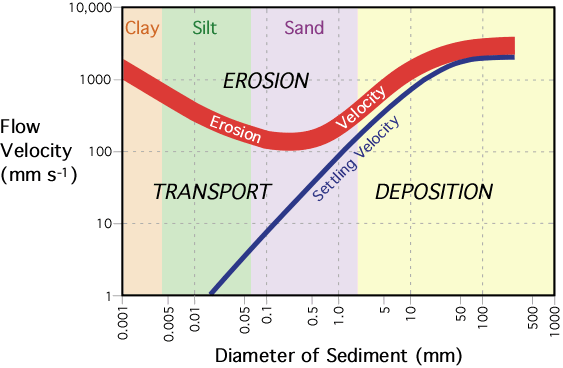 |
 |
|
|
Isostatic Effects of Deposition, Erosion, Ice-SheetsThe Earth's lithosphere "floats" in the asthenosphere. When the sediments or Ice-Sheets accumulate on the Earth, the immense weight may cause the crust below to sink. When large amounts of material are eroded away or melt the surface of the Earth, the land may rise to compensate. Isostatic Effects of Deposition, Erosion.The isostatic relationship is maintained as the crustal surface changes. For example, as a mountain range block erodes, the block will rise—it is not as heavy because the material is eroded away, and it does not need to “ride” as low in the mantle. The eroded material is deposited as sediment on the adjacent thinner continental blocks, which increases their weight, and they then sink farther into the plastic asthenosphere. Areas that are tectonically stable tend to be isostatically balanced.The critical entrainment velocity curve suggests that particles below a certain size are just as resistant to entrainment as particles with larger sizes and masses. Fine silt and clay particles tend to have higher resistance to entrainment because of the strong cohesive bonds between particles. These forces are far stronger than the forces of friction and gravity.  This graph describes the relationship between stream flow velocity and particle erosion, transport, and deposition. The curved line labeled "erosion velocity" describes the velocity required to entrain particles from the stream's bed and banks. The erosion velocity curve is drawn as a thick line because the erosion particles tends to be influenced by a variety of factors that changes from stream to stream. Also, note that the entrainment of silt and clay needs greater velocities then larger sand particles. This situation occurs because silt and clay have the ability to form cohesive bounds between particles. Because of the bonding, greater flow velocities are required to break the bonds and move these particles. The graph also indicates that the transport of particles requires lower flow velocities then erosion. This is especially true of silt and clay particles. Finally, the line labeled "settling velocity" shows at what velocity certain sized particles fall out of transport and are deposited.
This graph describes the relationship between stream flow velocity and particle erosion, transport, and deposition. The curved line labeled "erosion velocity" describes the velocity required to entrain particles from the stream's bed and banks. The erosion velocity curve is drawn as a thick line because the erosion particles tends to be influenced by a variety of factors that changes from stream to stream. Also, note that the entrainment of silt and clay needs greater velocities then larger sand particles. This situation occurs because silt and clay have the ability to form cohesive bounds between particles. Because of the bonding, greater flow velocities are required to break the bonds and move these particles. The graph also indicates that the transport of particles requires lower flow velocities then erosion. This is especially true of silt and clay particles. Finally, the line labeled "settling velocity" shows at what velocity certain sized particles fall out of transport and are deposited.
Isostatic effects of ice sheets.The creation of ice sheets can cause the Earth's surface to sink. Isostatic post-glacial rebound is observed in areas once covered by ice sheets that have now melted, such as the Baltic Sea and Hudson Bay. As the ice retreats, the load on the lithosphere and asthenosphere is reduced and they rebound back towards their equilibrium levels. In this way, it is possible to find former sea cliffs and associated wave-cut platforms hundreds of meters above present-day sea level. The rebound movements are so slow that the uplift caused by the ending of the last glacial period is still continuing.Isostatic Effects of Plate TectonicsWhen continents collide, the continental crust may thicken at their edges in the collision. If this happens, much of the thickened crust may move downwards rather than up. In addition to the vertical movement of the land and sea, isostatic adjustment of the Earth also involves horizontal movements. It can cause changes in the gravitational field and rotation rate of the Earth, polar wander, and earthquakes. The crust thickens and the upper part of the thickened crust may become a mountain range. However, some continental collisions are far more complex than this, and the region may not be in isostatic equilibrium.
Sources of information:
1. Websites: - http://en.wikipedia.org/wiki/Isostasy - http://www.physicalgeography.net - http://www.answers.com - http://www.cliffsnotes.com |